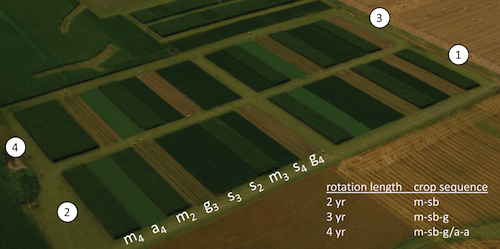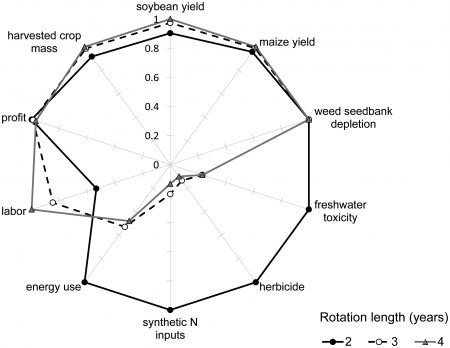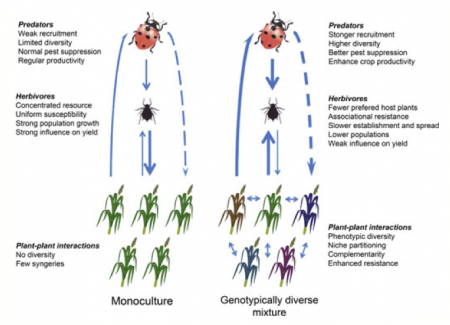- Sustainable value chains made easy. Perhaps too easy.
- An end to crazy EU agricultural subsidies? Don’t hold your breath. What would it mean for agricultural biodiversity?
- Yesterday it was rotation, today it is intercropping, and more. Is there something in the air?
- Ten new things we learned about trees this year. The one I would add is that eucalypts are rain forest species.
- Way more about high-throughput phenotyping than I need to know. But somehow still less than I’d like to know. Thanks, Tom.
After the storm
Despite Sandy, NPR’s Planet Money, which is made in New York, had a brief podcast on Friday. After The Flood, The Backup Plan examined the different ways in which the US economy speeds recovery after natural disasters. 1 One of those ways is insurance and, even more so, reinsurance.
Those are the guys who insure the insurers, and while the insurance business as a whole is certainly aware of the impact of climate change on their business model, one J. Eric Smith, CEO of Swiss Re Americas, was at pains to point out that their reserves are plenty big enough to pony up for at least a couple of big natural disasters simultaneously. That’s reassuring.
When asked who insures the re-insurers, Smith was forthright:
We’re insured by diversification.
Just sayin’.
Brainfood: Chinese fermented fish, Yeast diversity, Wild papayas, Milpa nutrition, Rare wild sunflower, Albanian pomegranate, Wheat mixtures, Climate change yield decline
- Chemical and microbial properties of Chinese traditional low-salt fermented whole fish product Suan yu. “The values of Enterobacteria and Pseudomonads were under the detection limits in six different brands” is about the best that can be said for it.
- Tapping into yeast diversity. Some new, diverse wild lineages in China may tell us important things about yeast ecology, evolution and domestication.
- Genome size variation among sex types in dioecious and trioecious Caricaceae species. Lots of retrotransposons, and sex chromosomes in some species.
- The Archaic Diet in Mesoamerica: Incentive for Milpa Development and Species Domestication. The diet preceded the crops.
- Genetic diversity and population structure in the rare Algodones sunflower (Helianthus niveus ssp. tephrodes). Low diversity overall, but some populations quite distinct. Which tells you about how to conserve it.
- Albania, the domestication country for pomegranate (Punica granatum L.). Well, maybe.
- Mixtures of genetically modified wheat lines outperform monocultures. Two transgenes are better than one.
- Climate change impacts on crop productivity in Africa and South Asia. -8% overall. The surprise? Sorghum declines more than maize in Africa, less in S Asia.
Nibbles: Using genebanks, Fonio collecting, Bean breeding, Caribbean PGR networking, Cotton breeding, Conflict prevention, Beer foam characterization, Soil microbes, 7ITS
- IRRI DG on the Kasalath story and its wider implications.
- French collect fonio. Glad someone is.
- CIAT bean breeder complains about having too much diversity to play with.
- Caribbean needs a regional genebank, catalogue of germplasm. What, still?
- Improving cotton in Texas one (or two) chromosomes at the time.
- Managing livestock-predator conflicts. The name of the game is prevention.
- Candidate gene for improved beer foam identified. I knew all that genomics stuff would come in useful eventually.
- Diverse root biome helps plants survive drought.
- Gear up for the 7th International Triticeae Symposium, or 7ITS as it is widely, if unfortunately, known.
Benefits of agricultural biodiversity explored

![]() Two recent papers — one a report of a long-term experiment, the other a literature review — point to the benefits of diversity in agricultural systems. Adam Davis and his colleagues report that Increasing Cropping System Diversity Balances Productivity, Profitability and Environmental Health, 2 a result that has already triggered all sorts of commentary on the web. By contrast, John Tooker and Steven Frank’s paper Genotypically diverse cultivar mixtures for insect pest management and increased crop yields 3 has not yet created much of a stir. But that’s OK. We’re equal opportunity bloggers here.
Two recent papers — one a report of a long-term experiment, the other a literature review — point to the benefits of diversity in agricultural systems. Adam Davis and his colleagues report that Increasing Cropping System Diversity Balances Productivity, Profitability and Environmental Health, 2 a result that has already triggered all sorts of commentary on the web. By contrast, John Tooker and Steven Frank’s paper Genotypically diverse cultivar mixtures for insect pest management and increased crop yields 3 has not yet created much of a stir. But that’s OK. We’re equal opportunity bloggers here.
Lengthen those rotations
Davis et al. report on an experiment that ran from 2003-2011 at Marsden Farm, Boone, Iowa. (That’s it in the photograph at the top.) They compared three different regimes: a standard 2-year corn (maize)-soybean rotation, with ample nitrogen and herbicides to keep the weeds down; a 3-year rotation, adding a small grain (triticale and oats) with red clover in the third year; and a 4-year rotation that added an additional year of alfalfa after the small grain.The two more-diverse systems received some fertilisers and herbicides, but only as much as was needed, rather than at rates matching those of surrounding commercial farms.
The paper is open access, so you can go and read the whole thing, or just focus on the crucial results neatly depicted in this figure:

This shows 10 variables, with the levels of each treatment (rotation-length, or system diversity) normalised so that whichever has the top score is 1.0. Crucially, there are no significant differences among the treatments in profit, harvested crop mass, soybean yield, maize yield, or weed control. There are big differences in the toxicity of run-off water (200 times lower), herbicide use, nitrogen use, energy use and labour, the only variable in which the more complex systems scored higher than the less (and in an economy looking for jobs, that may be no bad thing).
One of the more interesting results, given the tendency to assume that greater diversity in a farming system inevitably stabilises yield, is that it doesn’t. In fact, “[v]ariance in mean harvested crop mass was greater in the 3-yr and 4-yr rotations than in the 2-yr rotation”. Ah but …
Conversely, cropping system diversification was associated with lower variance in profit during the established phase of the study. Variance in profit from 2006 to 2011 was lower in the 3-yr and 4-yr rotations than in the 2-yr rotation.
It would be nice to see more detail on this stability of profit, even in the face of less stable overall yields.
The other crucial point from this experiment is that the researchers didn’t turn their back on either synthetic nitrogen fertiliser or herbicides. They did, however, make much less use of them. And yet yields were maintained.
In the more diverse rotations, small amounts of synthetic agrichemical inputs thus served as powerful tools with which to tune, rather than drive, agroecosystem performance.
Reintegration of crop and livestock production, as represented by the forage legumes and manure applications present in the more diverse systems, is not simply another aspect of cropping system diversification. Instead, it embodies an important principle in sustainable agriculture: system boundaries should be drawn to minimize externalities. Animal manure is produced regardless of whether feed grains are shipped to centralized concentrated animal feeding operations, or produced within integrated crop-livestock farming operations. In the former case, the manure may become a waste product and water pollutant if quantities exceed available land area for field application [33], whereas in the latter case, it contributes directly to crop nutrient requirements, improves soil quality, and reduces fossil fuel subsidies associated with grain transport and external N fertilizer inputs [14].
Battling pests with biodiversity
Unlike Davis et al., Tooker and Frank present a review of existing evidence. Their article is behind a paywall, but to be honest unless you’re looking for a quick annotated bibliography on this important subject, I wouldn’t bother coughing up. The review is comprehensive enough (although some material is unaccountably missing), the goal being to demonstrate that despite the convergence of
[m]ultiple lines of evidence … to support the potential of intraspecific variation to contribute to improve insect pest control … very little work has sought to develop empirical support or viable implementation practices in agricultural systems. Thus, implementation of this practice is limited.
And yes, there really are multiple lines of evidence that genotypic diversity (variation among varieties) and genetic diversity (variation at the variety population level) generally diminish the impact of pests. Not as much as for diseases, mind, but enough to wonder why there hasn’t been as much in the way of implementation. The effects may be bottom up, diverse mechanisms that reduce the ability of pests to find suitable hosts, or top down, equally diverse mechanisms that act through natural enemies of the pests.

Tooker and Frank offer a helpful summary diagram, which makes it a little easier to conceptualise the different ways in which diversity can protect against pests. The results, though, can be elusive:
For example, in separate experiments, mixtures of two oat varieties or five corn varieties were found to harbour significantly fewer pests (aphids and leafhoppers, respectively) than monotypic stands, but this effect was only detected when pest populations were large.
Digging back into the literature, they uncover several studies that at the very least ought to encourage fresh research.
[W]hile much remains to be learned about the role of genotypic diversity in ecological interactions and ecosystem function, the existing evidence is particularly tantalizing for agriculture because productivity, resistance to herbivores and resiliency to abiotic stress are essential features of sustainable crop production. Moreover, genotypic diversity could be implemented with relatively minor changes to agricultural practice. If theory and empirical results continue to support the strong effects of genotypic diversity for plant productivity, a simple new approach to farming may transform planting strategies and agricultural productivity.
And there, really, is the value of both papers. Instead of taking an ideological stand on “sustainable intensification,” whatever that may be, they both show ways in which agricultural biodiversity could be deployed to help farm systems provide more, more sustainably.